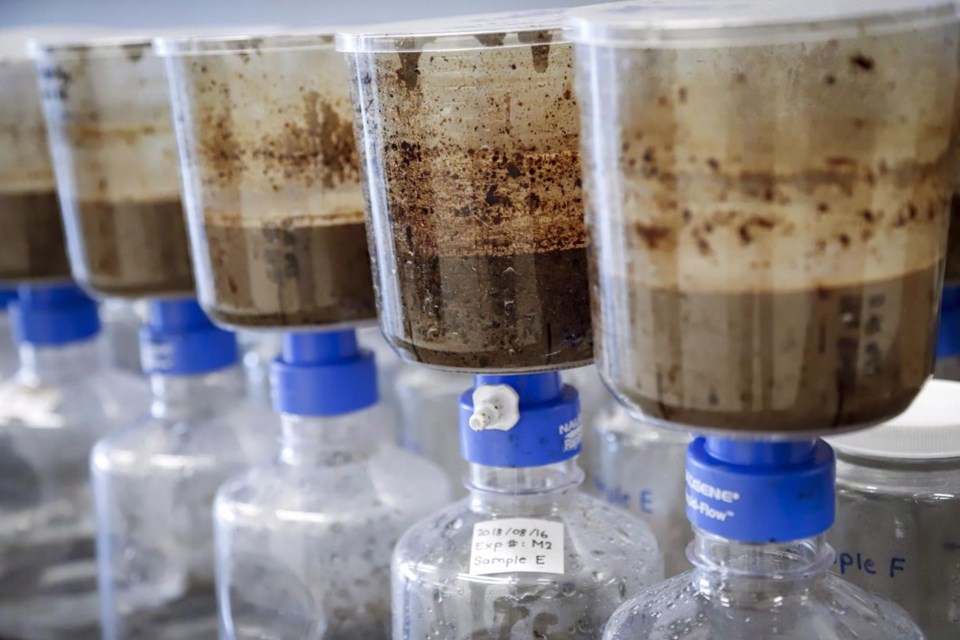A northern Alberta Indigenous leader has accused Imperial Oil Ltd. of a nine-month coverup over a massive release of toxic oilsands tailings on land near where his band harvests food.
Chief Allan Adam of the Athabasca Chipewyan First Nation said Thursday that Imperial executives had several chances to tell him in person about the leak after it was discovered in May. But he didn't learn about it until the province's energy regulator issued an environmental protection order on Feb. 6.
"During that nine-month period, ACFN had many meetings with them, including a sit-down, face-to-face between myself and the vice-president in November," Adam told reporters Thursday.
"Each meeting was an opportunity where they could have come clean, but they chose to hide the fact from us over and over again."
Imperial expressed regret over the communication.
"We recognize the communities’ concerns about delays in receiving additional information," said a Thursday statement from Jamie Long, Imperial's vice-president of mining.
"We have expressed to (Chief Adam) directly our regret that our communications did not meet the expectations of the (Athabasca Chipewyan) community," he said.
"We further committed to him that we are taking the necessary steps to improve our communications so this does not happen again in the future."
Shane Thompson, environment minister of the Northwest Territories, said the Alberta government broke an agreement with the territory by not telling it about the spill. The N.W.T. is downstream of the oilsands.
"This lack of transparency and information sharing from our Alberta partners is not an isolated incident, which increases our frustration in this matter," he said in a release.
"This failure comes at a time when the Alberta government is asking for trust and co-operation from the N.W.T. as they work towards regulations to allow the release of treated oilsands tailings effluent into the environment."
Thompson said he has asked for a meeting with his Alberta counterpart Sonya Savage to ensure the agreement between the two jurisdictions is upheld.
Imperial employees first reported seepage was escaping from a tailings pond and making its way to the surface in May. The company confirmed the seepage was tailings wastewater that made its way through a fill layer.
The unknown quantity of wastewater exceeds federal and provincial guidelines for iron, arsenic, sulphates and hydrocarbons that could include kerosene, creosote and diesel. The seepage has continued.
In addition, 5.3 million litres of water escaped from a catchment meant to capture escaped tailings. That makes it, on its own, one of the largest spills in Alberta history.
The tailings leaked onto muskeg and forest as well as a small lake and tributaries of the Firebag and Muskeg rivers.
No public notification was made of the two releases until the Alberta Energy Regulator issued the environmental protection order. By then, says Adam, his people had been harvesting, sharing and eating food harvested from adjacent lands for months.
"We have land users in the area that hunt and fish animals that could have been exposed to these deadly toxins. We have been eating them for months unaware of the potential danger."
Imperial has said there have been no impacts on water or wildlife as a result of the releases.
"It's going to be hard for me to believe anything that comes out of the representatives of Imperial or from the (regulator)," said Adam.
Band members have photographed moose tracks going through the affected area. People have been told not to consume wildlife from the area, and the community of Fort Chipewyan has diverted its water source from the Athabasca River to a reservoir.
The regulator ordered Imperial to provide plans on how it would stop the releases and prevent future ones by Feb. 28. Imperial was also ordered to provide a monitoring and remediation plan as well as a public communications plan.
A spokeswoman for the regulator said Imperial has met those requirements.
In a statement, the regulator said notifying affected people about releases isn't its job.
"It is the licensee’s responsibility to report fluid releases to affected or potentially affected parties as soon as they become aware of the release," it said.
An investigation has been launched, it said.
In a statement, Long said Imperial values its relationships with local communities.
"We recognize there are concerns about recent issues at our Kearl oilsands operations related to the release of industrial wastewater. We regret these incidents and are making every effort to learn from them and prevent them from happening again."
Imperial has installed extra monitoring and pumping wells to try and control the seepage. Trees and topsoil in the area have been stripped. It said further water catchment areas will be built.
Enforcement officers from Environment and Climate Change Canada have been on-site.
The risk of a tailings leak was pointed out in the mine's original environmental assessment. The Joint Panel Review that assessed Kearl noted the “tailings pond was sited in an area that had very permeable deposits."
Evidence that oilsands tailings have been seeping into groundwater from at least some of the mines in the area dates back to at least 2009, confirmed by at least two scientific studies
"How many more tailings leaks are taking place right now?" Allan asked.
This report by The Canadian Press was first published March 2, 2023.
Bob Weber, The Canadian Press




